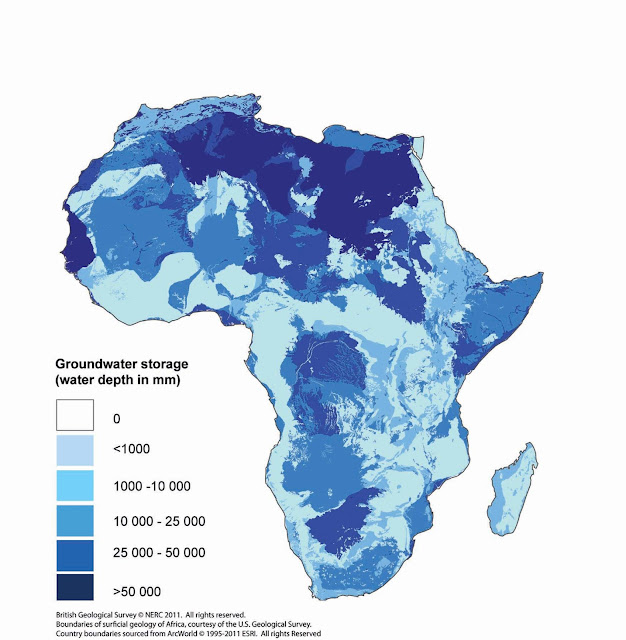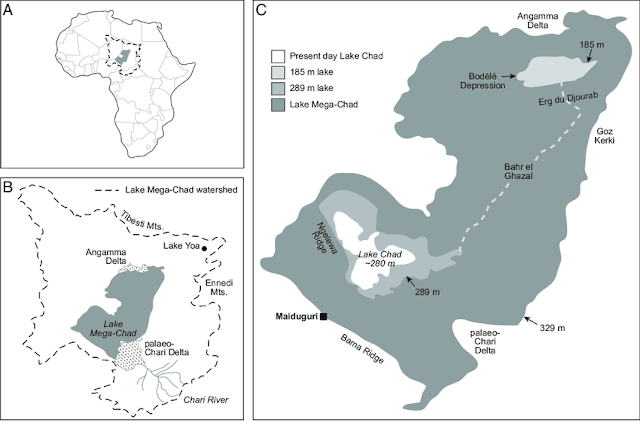Groundwater, environmental change and the Lake Chad Basin (LCB)
The LCB is one of the largest sedimentary groundwater basins in Africa and it is characterised by 3 climatic zones: hyper-arid/arid, semi-arid and sub-tropical (Vassolo 2012). Over 2/3 of the LCB occupies the arid-zone and hence does not provide water for maintaining the surface flow of the lake (Candela et al. 2014). The main source of recharge for aquifers in the LCB comes from the surface waters of Lake Chad and the rainfall it intercepts. However, this means that recharge can vary greatly as precipitation is unreliable and as a result, the aquifers are very sensitive to climatic change (Global Water Partnership 2013). Rates of groundwater abstraction in the basin have been increasing since the mid-20th century and as a result, the Lake Chad Basin Commission was established to address water management issues.
The Lake Chad Basin Commission (LCBC)
The LCBC was established in 1964 by founding member nations: Cameroon, Chad, Niger and Nigeria (Adenle 2004). The CAR subsequently joined in 1994 and Sudan in 2000. The LCBC was established for the management of transboundary resources in the basin, namely, water (Global Water Partnership 2013). However, some argue that the LCBC have done little work with regards to groundwater since the commission was established (Vassolo 2012). From 2010-2011 the LCBC underwent a restructuring in hope of tackling issues of groundwater management in the basin. All aquifers in the LCB are transboundary and so member states of the LCBC must negotiate a maximum volume of water they can extract. The maximum extraction volume is determined by ecological discharge which is the flow require to maintain ecosystems in a 'good' condition. Issues of groundwater management extend across the continent as nations are increasingly turning to groundwater resources to meet the food and water demands of growing populations.
The African continent
Africa’s groundwater supply is thought to be over 100 times greater than its surface water resources. Compared to surface water, groundwater is generally considered more locally accessible and more reliable than rainfall in many regions. Hence, groundwater tends to act as a more effective buffer to climate shocks as well as a store to draw upon between wet and dry seasons which are becoming increasingly variable. (The World Bank 2017).
Figure 1: A map showing the estimated groundwater storage on the African continent.
Source: British Geological Survey
Figure 1 shows the estimated depth of groundwater across Africa and although this does not necessarily reflect the volume of accessible water, it indicates that much of North Africa in particular does potentially have more water than what was once thought. As well as increasing seasonal variability in climate, there is a growing demand for food production as the population continues to grow. Although much of this food production is grown by small hold farmers and their crops are rain-fed, there is a growing demand for irrigated agriculture and so groundwater abstraction is playing an increasing role (McGrath 2012).
Southern Africa
A recent article on the relationship between climate change and groundwater in Southern Africa described how authorities in South Africa have increased their reliance on groundwater supplies in order to relieve pressure on surface water resources which are generally more unreliable (Moyo 2018). Moyo claims that authorities have invested in both infrastructure and the transfer of knowledge across the nation in order to ensure the sustainability of groundwater abstraction. The following video (Figure 2) shows the impact of coal mining on groundwater in South Africa. The mining industry has had a profound impact on many flows in the hydrological cycle. In addition, groundwater contamination as a result of oil exploitation and industrialisation has also been cited as problem in the LCB (Global Water Partnership 2013).
Figure 2: A short video on the impacts and management of coal mine solution on groundwater resources in South Africa.
Source: YouTube
Source: YouTube
Some of the ways in which environmental change has affected groundwater in the LCB is mirrored across Africa. However, the extent to which nations utilise groundwater varies significantly and therefore, management of groundwater resources also varies greatly.




This is an interesting post and covers subject matter rarely discussed. The South African adaptive strategy using groundwater is interesting and reflects changes in cape Town that occurred in response to last year's water crisis. To what extent does groundwater use or variations in recharge influence lake levels? Any evidence here? Have a look at this paper: https://agupubs.onlinelibrary.wiley.com/doi/full/10.1029/2003GL018094
ReplyDeleteI think the extent to which groundwater recharge variations affect level levels really depends on the individual lake. In the case of Lake Victoria (which I discussed in my most recent post!), fluctuations in lake level are heavily dependent on the amount of rainfall directly onto the lake and so climatic variations are likely to have a greater effects on lake level than groundwater.
Delete